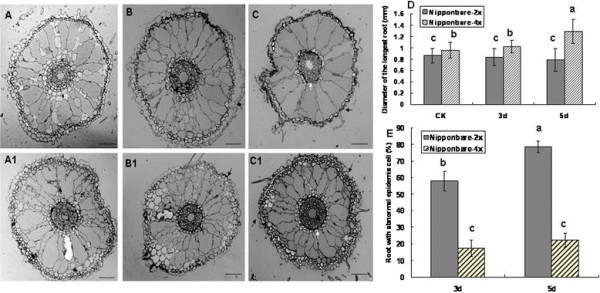Figure 5.

The longest root microstructure, diameter, and abnormal epidermis frequency of Nipponbare-2x and Nipponbare-4x under salt stress (Bar = 50 μm).(A) Roots of Nipponbare-2x under normal conditions. (A1) Roots of Nipponbare-4x under normal conditions. (B) Root of Nipponbare-2x under salt stress for 3 days, whereby the black arrows show the epidermis cells abnormally shelled. (B1) Root of Nipponbare-4x under salt stress for 3 days, whereby the epidermis cells maintained a normal station and the black arrow shows regularly thicker endodermis cells. (C) Roots of Nipponbare-2x under salt stress for 5 days, whereby the root shrank and transfigured; the black arrow suggests that the epidermis became thinner. (C1) Root of Nipponbare-4x under salt stress for 5 days, whereby the protective gap formed between the cortex cells and pericycle cells (white arrow) and the epidermis cells became much thicker (black arrow) and were in close contact with each other. (D) Diameter of the longest root; (E) Frequency of roots with abnormal epidermis cells under salt stress.
